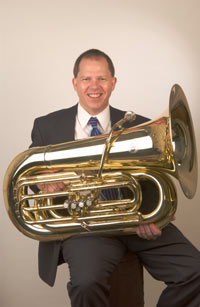

|
TUBA TIPS FOR PLAYERS & STUDENTS - From NorlanBewley.com "Breathing For Tone" Breathe as often as you need to for a great tone. Try to stay full of air. Breathe often enough and deep enough so that you feel full of air all the time. Make sure to breathe through your mouth to get a deep breath. Shallow nose breaths will not do for this (sniff breathing is something else). Breathe deep enough and full enough so that your body feels like it wants to get rid of the air. This may feel a little uncomfortable at first, but you will quickly get used to it. It is possible to be too full of air, but it is unlikely. If you are so full of air that it would be hard to sing, you are too full. Again, it is unlikely that you will be too full of air. You will need to redefine being full of air. Normally, when you are half full of air you would think that you have plenty of air left, but you don't. Think of half full as empty! You want to stay as close to full as possible. Most of the time you will be between full and ¾ full of air to get a great tone. Think of using half of your air to help propel the other half out into your tone. When you are half full, all you have left over is the air that you use for propellant. This will not feel empty at first, but it is for a great tone. To go past half full, you start to squeeze the air out, which is not good. It will still make a sound, but not a great tone. Breathe often enough to stay as full as possible. The more you breathe, the better you will learn to breathe. Done correctly, it will feel like the horn is sucking the air right out of you (see Tone Production Steps 1 and 2). Breathe to try and keep up with this. You will learn to breathe deeper and quicker. Give your breath a rhythmic value, like a quarter breath or eighth breath. Breathing in rhythm is important for your music and for the timing skill you need to play the right notes with a great tone. This way, you know when you will breathe, how long you will breathe, and when you will play the note. You can only get this from breathing in rhythm. Remember: The number one musical reason you breathe is for your tone. Any other reason is secondary. This doesn't mean the other reasons aren't important, just that without your tone you have nothing else. No phrase, no crescendo, no forte, no legato, no staccato……nothing. Develop your tone first and then learn to phrase, etc. Without a great tone, no one will really want to listen to you anyway, so breathe as often as you need to for a great tone. Copyright Norlan Bewley 1999
|
 |
 |
 |
 |
| Biography | Online Music Store | Low Brass Ensemble | Instruments | mp3 Sounds | Bewley Music | FAQ | Low Brass Tips | Sheet Music |
